#Independent School Washington DC
Text
Nuturing the intellectual, social, and emotional growth of each child. Our research-based approach combines innovative teaching, personalized learning, and a strong emphasis on social-emotional development to create a dynamic and inclusive learning environment.
Read more at https://theriverschool8.blogspot.com/2024/08/nurturing-whole-child-comprehensive.html
#kindergarten washington dc#independent school washington dc#preschool washington dc#private school washington dc
0 notes
Text
Explaining my no capes dc dr!!

Overview :
The ‘Justice League’ is a global aid organization bankrolled by donations and sponsorships from everyday citizens, big name corporations, and important public figures alike.
Much like the American Red Cross, the Justice League strives to provide humanitarian aid in times of crisis as its main priority.
The Justice League’s other purposes include fostering world peace, making scientific and medical advancements, exploration of the ocean and space, and more.
Based on it’s predecessor, ‘The Justice Society of America’, or the ‘JSA’ : The Justice League was founded to globalize the scope of the JSA’s original mission, focused on providing aid and criminal justice.
The Justice League, while primarily American based, is politically independent from any nation. Though the ‘JL’ does occasionally engage in political discussions and activities.

Important Members :
Bruce Wayne
A multi billionaire who is one of the primary sponsors of the JL. Using the revenue he generates from his company Wayne Enterprises and his platform as a beloved public figure, Bruce Wayne is a very important member of the JL.
Most people can only speculate the extent of his involvement in the JL, as all sponsors gain auto membership, however other members know that Wayne is a very active participant in JL activities. Preferring to do most of his humanitarian work with the JL under an alias in attempts to separate it from his less serious public persona.
Clark Kent
Clark Kent is a fairly well known American journalist. If you are in journalism circles or care a lot for the news, then you would most definitely know the names of both him and his wife, Lois Lane. Kent uses his journalistic writing to create think pieces and the occasional expose.
However where Kent really shines is with hope. In the midst of darkness, Clark Kent provides people with a positive outlook on any situation, along with actually resources they can utilize in bad situations. Kent is also very prominent during hands-on humanitarian missions, always being the first to volunteer to go into the field and make a difference.
Diana Prince
Diana Prince is a peace ambassador from the previously closed nation of the Amazons, more specifically the island of Themyscira. One of the few remaining Princesses in modern society, Prince takes a very active role in advocating for world peace.
Prince is also a big advocate when it comes to women’s rights and the intersectionality of feminism. From this Prince has become a beacon of hope for women around the world, and several help centers and shelters for women and children have been opened in her name.
Other
There are many other important and active members of the JL, each with their own areas of focus and skill set, all coming together to make the world a better place.

Additional Notes:
Because there are not superhero’s, heroism is shown through activism here
The political and like overall state of the world is much more lax so while they are activists and provide aid, there isn’t much bad stuff to provide aid about (yay!)
Most of the people in the JL are like rich and or influential people who utilize their platform
The JL is a volunteer organization, so it’s not most members day to day job
The JL has a headquarters in Washington, D.c. that used to be the headquarters for the JSA
JL members aren’t expected to come into the headquarters everyday or anything like that so they live sort of scattered
The Wayne family has a TV show
‘Villains’ are just generally people who operate extralegally, but people don’t really have superpowers or gimmicks
Even crime though is much less extreme and harmful (yay!)
Almost all the ‘sidekicks’ are massive nepo babies lol
Most of the ‘sidekicks’ just started engaging in activism when they were younger, teenage activists is not an unknown concept or anything
Due to the education mission of the JL, they opened up a school (I haven’t decided if it should be highschool or college/university) which is where most of the groups like ‘teen titans’ or ‘young justice’ could meet and operate together as like a group
^(if it’s highschool then it is likely some sort of alternative school)
Anyway that’s all for now!! thank you for readinggg <3

#me yapping#reality shifting#shiftblr#desired reality#shifting#scripting#dc dr#shifting realities#desired reality shifting#shifting community#shifting script#shifting blog#shifters#This is a mess rn but i've been really excited about this one so I wanted to share#:)#Idk i'm maybe thinking of incorporating this into my better cr#cause i really like these people lol#collecting all the dc shifters i can find#anyway yeah
13 notes
·
View notes
Text
Madrid Week 3: Flashbacks
Hola a todxs! It’s Niko back with week 3 of studying abroad in Madrid. Time is STILL passing by really fast and slow at the same time, so I'll talk about it again — I’ve been here less than a month and it’s felt like half a year, but the days go by quickly. I don’t think that will stop anytime soon, but I’m here for it. More perceived time = more life lived, and I hope that my weeks don't start blending together anytime soon.
As promised in week 2, I wanted to spend this blog talking about my trip to Granada last weekend. Granada is a small Spanish town in the southern region of Spain called Andalucía. It’s got a population of around 230,000 people — nearly the exact same as my hometown of Arlington, VA, which is a suburb outside of Washington, DC. However, in place of tree lined residential neighborhoods and modern office buildings, Granada is filled with narrow cobblestone streets bordered by low, densely packed buildings and intensely intricate churches/palaces built hundreds of years ago.

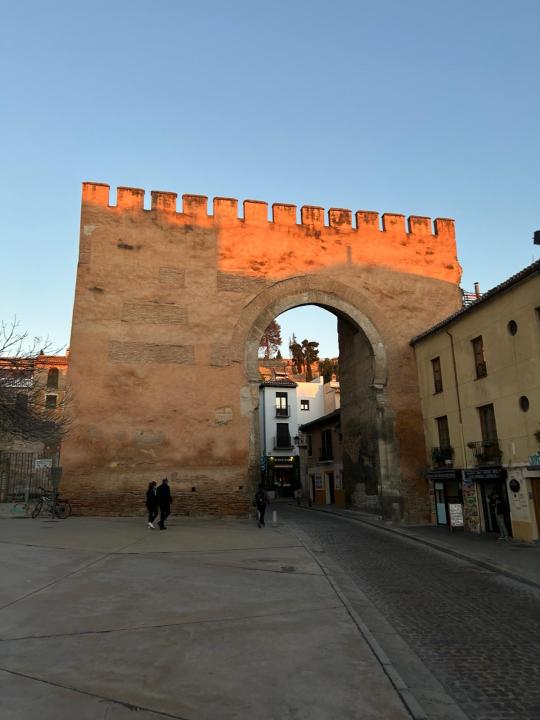

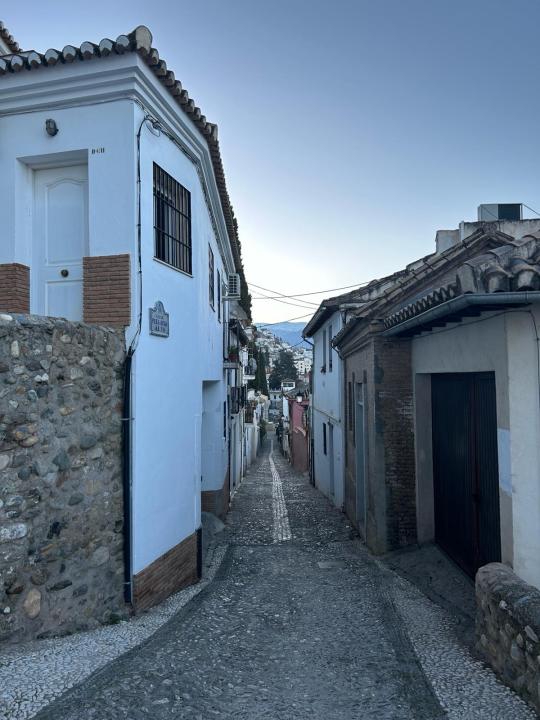
That palace — La Alhambra — is the largest tourist attraction in Granada, and was one of the main reasons I wanted to visit it (also, a big shout out to Emma for hosting me, a friend of mine from high school doing her semester in Granada!!). It’s a massive Moorish palace on a hill that overlooks the entire city. The Moors, who were North African Muslims, conquered much of the Iberian Peninsula in the 8th century. La Alhambra was slowly built between the years 1238 and 1358, during the reigns of Ibn al-Aḥmar and his successors.
With that said, my trip to Granada last weekend was not my first time seeing La Alhambra. As I mentioned briefly in week 0's blog, I took a trip to Spain with my 8th grade Spanish class for a week. That was 7 years ago. We hit most of the main touristic Spanish cities within that time, Granada included.
So, walking through the palace last weekend triggered a slow trickle of distant memories, fuzzy enough that I couldn’t remember details, but potent enough that I could remember how I felt. Some things had changed about the palace, many things stayed the same. I still felt the same sense of awe I did 7 years ago witnessing the incredible detail hand-carved into every surface, or seeing the palace perfectly reflected in a courtyard’s pool. The difference was that this time, I was exploring alone.





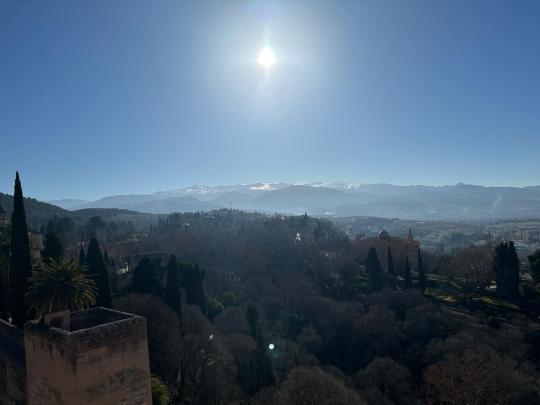
I think that during this trip, I really gained an appreciation — and curiosity — of solo travel. Although I was with my friend Emma much of the time, I felt a great deal of peace in exploring La Alhambra at my own pace. Without anyone else to turn to, I was forced to be present and attuned to my surroundings, and that enabled me to appreciate them that much more.
I think that part of that appreciation, however, was derived from the sense of independence and freedom I had existing alone in Granada. Going into college, being alone terrified me. I would step into the dining hall for lunch and wander through the common spaces, looking for a familiar face I could share a meal with. Now, I try my best to cherish the moments in which I can connect more to myself, whether that be during a meal, practicing a hobby, or exploring an ancient Moorish palace. That’s only something I've been able to move towards through consistent practice -- AKA, spending deliberate time alone. I hope to continue deepening that connection throughout this semester solo-exploring Spain and Europe, which I know is something I'll carry with me for the rest of my life.
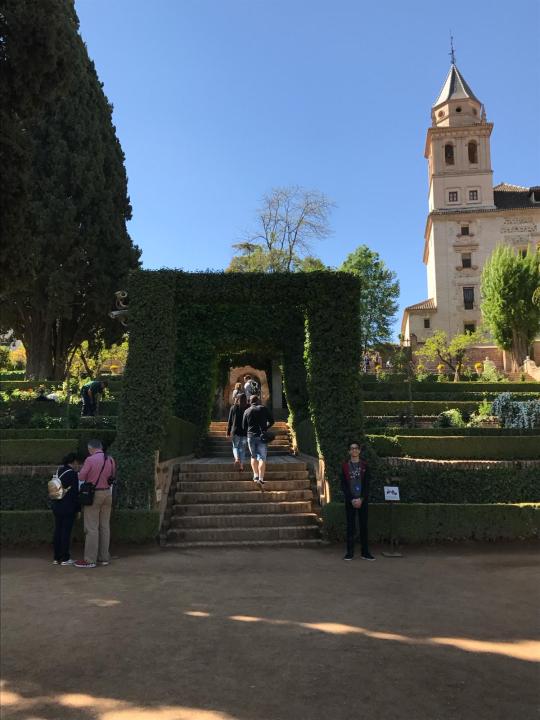
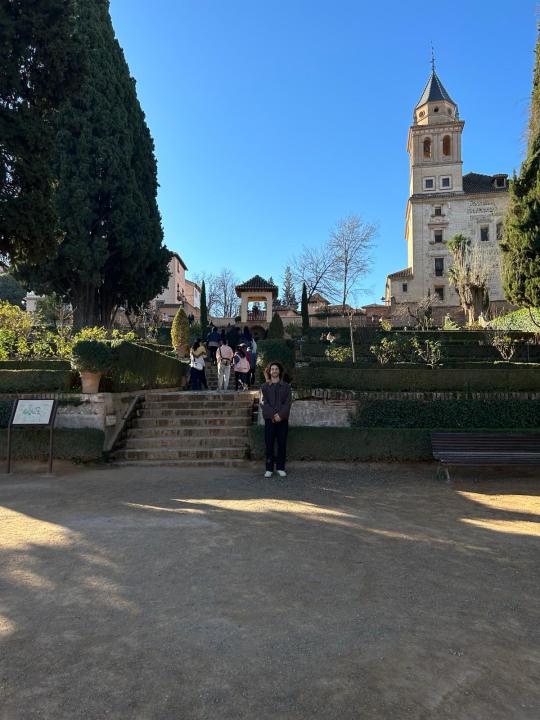
Aside from La Alhambra, Emma and I explored the city and its various landmarks (El Albaicin, a predominantly Muslim neighborhood, the Granada Cathedral, the Monastery of San Jeronimo, the Mirador de San Miguel Alto [and an epic sunset], and even a jazz-esque show with Spanish flair from a band at a local music club). More pictures below.




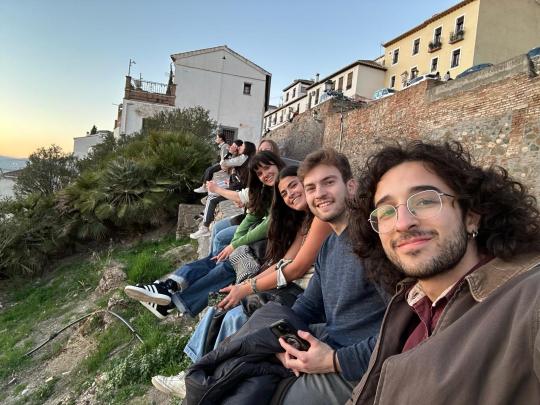
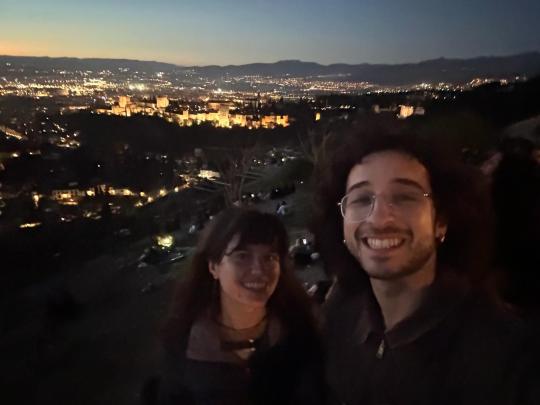


On the way back home, we stopped at a rest stop for the bus, and I couldn’t help but notice how familiar it seemed. It conjured up a nostalgic feeling that could have only come from my first trip in Spain — I realized we had stopped at the same station.
For old time’s sake, I bought a Kinder Egg Sorpresa. These things were a huge deal to me in 8th grade, as they are banned in the USA for being a ‘choking hazard’. Inside the chocolate exterior was a little plastic goat toy that will now serve as the centerpiece of our dining room table.

It’s funny to think how much of a different person I am from the 13 year old on vacation with his school friends and Spanish teachers. But it’s also comforting to know that all of these memories I carry with me explain the person I am today.
This week, I got a little more into school groove, took a rollerblading route, visited the Reina Sofia museum and went to see some amazing techno DJs over the weekend. Per usual, check out the photo captions for more info on the content this week :).
Hasta luego,
Niko Economos
Aerospace Engineering
Universidad Carlos III de Madrid
Madrid, Spain
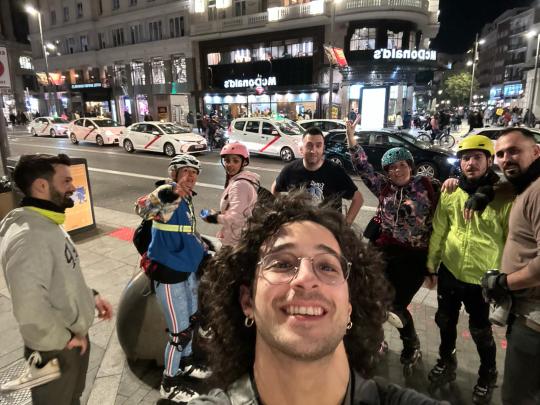
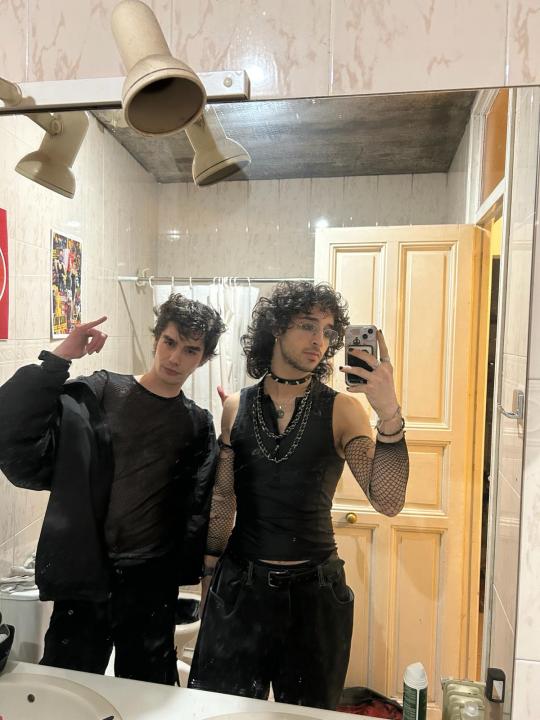

4 notes
·
View notes
Text






















National Flag Day
America’s Flag Day marks the Second Continental Congress’s adoption of the first U.S. national flag on June 14, 1777. The first flag featured the same 13 red and white stripes we see today. However, the number and arrangement of stars have changed as the number of states has increased over the centuries. The current flag has remained the same since 1960. Will we ever go from 50 to 51? Read on for a look at some possible statehood candidates. And consider this a warmup for Independence Day — in just 20 days.
Flag Day timeline
1776–1777 First American Flag Created
Continental Congressman Francis Hopkinson designs a United States flag and a flag for the U.S. Navy, however, Hopkinson's naval flag becomes the preferred National flag and the Continental Marine Committee sponsors the U.S. Flag Resolution on June 14, 1777.
1916 President Woodrow Wilson Recognizes Flag Day
Celebrating the selection of the first American flag back in 1777, President Wilson signs off on establishing June 14 of each year as Flag Day.
July 4, 1960 The Current U.S. Flag is Completed
The 50th star, representing Hawaii (not Alaska), completes the flag flown in the U.S. today.
July 20, 1969 The U.S. Flag Sees the Moon
There are now six U.S. flags present on the moon, but the first was placed by Neil Armstrong in 1969.
Flag Day Activities
Plan a costume contest as part of a BBQ
Teach your kids or less informed friends a history lesson
Make a healthy patriotic snack
The stars and stripes aren't just for flags anymore. Take the opportunity on Flag Day to sport the red, white, and blue on socks, bathing suits, and hairstyles. It's a perfect day to celebrate your patriotism with a fun twist.
An American flag trivia game is a quick and easy way to learn a few tidbits. Most people know that each star represents a state, but do they know that a new star only appears on July 4 following a state's admission to the Union? Trivia - bam!
Strawberries, blueberries, marshmallows, OH MY! Some of our favorite fruits lend themselves very well to creating flag-themed cakes, so roll with it. Fine, marshmallows aren't a fruit, but they're basically a summer necessity, so we'll let it slide.
5 American Flags — By The Numbers
50 — and counting
49
48
31
13
We've been at 50 for nearly 60 years. Possible candidates for the 51st star? Puerto Rico, Guam, and Washington, DC.
Seven times seven? A perfect square. There's just so much luck in this flag, we need to thank Alaska (January 1959) for joining us. This one had a short reign. Hawaii (August 1959) would soon make it 50.
It featured such beautiful symmetry with the addition of New Mexico and Arizona in 1912 and flew proudly for 47 years.
The number 31 doesn't easily lend itself to neat patterns. If we didn't actually love California (added in 1850) so much, we'd probably have made it secede after seeing the lack of symmetry. (This flag lasted seven years!)
America's original flag, it's the only one that dared defy the straight line pattern of all its successors. If you ask us, the 13 stars in a circle better represent the unity of the, uhhhh, union.
Why We Love Flag Day
A chance to show patriotism
Parades
It reminds us summer is near
It's easy to get so caught up in our day-to-day lives that we sometimes forget to be thankful for the bigger picture. Flag Day reminds us that we are one country — united — despite our disagreements.
Americans love to have parades for many events and holidays. Mid-June is the perfect time to set up that camping chair on the street corner and watch the local firefighters, school bands and dance troupes strut their stuff.
The weather is starting to behave, kids are wrapping up school, and BBQ season is upon us. Flag Day gives us another reason to celebrate outside and enjoy the sunshine.
Source
#Bend#Maryhill#Charlie Lake#Canada#Turnbull Wine Cellars#Oakville#Stars and Stripes#US Flag#14 June 1777#anniversary#US history#Flag Day#FlagDay#Chicago#architecture#USA#cityscape#Flight 93 National Memorial#DeWitt#New York City#Manhattan#Annapolis#tourist attraction#landmark#vacation#travel#original photography#Paoli Battlefield Site and Parade Grounds#St. Helena#Malvern
2 notes
·
View notes
Text

[ SEO IN GUK, 36, NONBINARY, HE/THEY ] Welcome to Antioch, ISEUL KANG ! Local sources report that you’ve been in town for TWENTY-FIVE YEARS and are known to be ATTENTIVE yet JITTERY. Others have dredged up rumors that you’re involved in THE STELLAR SOCIETY as A CULT DEFECTOR, but most know you for your work as a DELIVERY DRIVER at KILLER PIZZA. We’ll see you around town soon! ⸻played by kira.
stats :
character name: iseul kang 강이슬 / nicknames: isu, seullie / face claim: seo in guk / birthday: january 15th / place of birth: washington, dc / sexuality: panromantic pansexual / zodiac: capricorn / mbti: infp / moral alignment: chaotic neutral / occupation: delivery driver / place of work: killer pizza / subplot affiliation: defector from stellar society / three positive traits: attentive, independent, determined / three negative traits: jittery, impulsive, uneasy / languages: korean, english, some spanish / love language: quality time
biography :
﹙ death , funerals , blood , torture , burning , scars , cults , child neglect allusions , disassociation cw ﹚
you grow up in a big city and get used to the rush that's always around you. hurrying to make it to your school bus after breakfast, a constant itinerary of tasks on the weekend when you have a few hours with your parents. their time is precious, so you get used to always being on the clock around them.
either dad or mom picks you up from school, and it's every once in a while that they just are too busy to do so. you stay at the building after class, do your homework. you're a quiet child, hunched over your desk, sketching figures around your homework, reading sci-fi books that you borrow from the library.
they are usually apologetic, telling you they are working on a big case and are nearing a breakthrough, and that there are lives at stake. sometimes you are furious at the fbi for stealing your parents from you so often. that someone else's children take precedence over you. little do you know, how true your words will become.
then, you feel guilty when they come back home and pretend as if they aren't affected by whatever they have seen. you hear their cries when they think no one is listening. you don't know who to hate for causing all this pain.
you are eleven when they tell you they are being reassigned to oregon, to a small town, in the middle of nowhere by your standards. you throw fits about how they are uprooting your life, how you will lose all your friends. you believe that they are choosing their work again, over you, and you decide to pin the blame on them and the government.
life in antioch is much different than what you'd expect. your parents grow quieter, do more overtime, stay at home much less. there is still that rush of having limited time together, though you can also feel them growing distant. it must have been their trust in a smaller city, or you growing older, that they let you on your own much more often.
you prepare your own lunch, you go home on your home after school. it's fine- you make new friends, new acquaintances. you are also freer to explore this weird town that you find yourself in, the courage of adolescence running through your veins, not afraid to poke your head into spaces that you don't belong.
this habit spreads to your home as well. you try to figure out what's the top secret case your parents are working on, try to unlock their laptop, and read through their files. there is little to be found, and what you find makes no sense at all. once you are caught, you see fury you have never seen before in their eyes, mixed with fear. after that, they never bring any work-related documents back home, spending more and more hours at the government facility.
when you look back now, you swear you knew something was going to go wrong that day.
you are twenty, and it's supposed to be another day after classes when you step foot on the pavement right in front of your home. it's quiet, eerily so, and when you push your keys into the lock, the door is already open. it's colder than it should be, as if the air has been sucked dry. your home is ransacked, and in the middle of it, on a chair, someone sits.
they are wearing a pristine suit, and from many years of living around the fbi, you think this is a government agent. their expression is empathetic, yet closed off, in the way that you have seen many times on your parents. i am sorry iseul, i come bearing bad news.
everything changes that night. you are told both of them have been killed in action.
there are no bodies to be identified.
they spare no expenses on the ceremony.
you are alone as you stand by the side. you are alone as a calloused hand runs through your hair. you are alone when a folded flag is pressed into your open palms.
you are alone.
until you aren't. they give you a new home. a way to enact revenge. you can become someone here. you can reach the stars. can you face who you will become?
there's blood on your hands. time flows differently in stellar. there is a routine. you wake up, you serve the commune. you serve a higher being. you are finally worth something. you will find your answers. your answers do not matter.
there's blood staining your hands. you don't remember which year it is. sometimes, you can forget the two empty caskets buried six feet underground. sometimes, you cannot hear anything but the crackling of thunder, the way the soil hit the hardened wood. you can pretend it's their fault. that it has always been their fault. this, too, must be theirs.
sometimes, when the voices in your head are so loud, you can pretend you like this. then, you learn again that it doesn't matter. the drugs make you feel good when you don't.
you don't know what breaks, but only that it does. you don't want to do this anymore. it breaks and it breaks and it breaks. until there is nothing more.
you wake up. with sweat soaking the back of your shirt. away in an apartment flat that is nowhere near the woods. with knuckles that are scarred. with burn marks on your palms from wondering how hot fire is.
you got out. you think you got out. then, something shifts, and you are back there again, staring into the fire. your hands hurt.
then, another blink, and you stand there, broken glass under the soles of your shoes, in your family home.
then, you are back, with rain falling down on your windshield, with boxes of pizza on your passenger's seat.
you think you got out. you try to convince yourself. until, colors shift back again.
wanted connections :
childhood friends ﹙ 0 / ? ﹚: iseul has moved to antioch when he was eleven. starting school mid-year with a completely new class, there are a lot of options on how this could go:
─ negative : maybe your muse didn't like they were an outsider, so they were very much annoyed at each other. this could have been mended through the years, or they still glare at each other whenever their paths come across.
─ positive : or your muse was the friend who sat down next to him during lunch, and made him feel welcome. i would like this to potentially stretch across years, but we can discuss how they are w each other now.
people who worked with / knew his parents ﹙ 0 / ? ﹚: if they were alive, his parents would be over fifty-five years old, and they died approx. sixteen years ago. if your muse were around antioch or washington dc sixteen years ago (or more), i would love to explore any relationship they would have had with iseul's parents. this could be that your muse also worked for the government, or they were part of a case that's related to your muse. iseul has a very complicated relationship with his parents, so this would be interesting to explore.
star children ﹙ 0 / ? ﹚: other stellar society members.
─ negative : people who are angry at him for defecting. can find him ungrateful, and either try to convince him to return, or disappear completely.
─ positive(ish) : even if iseul is adamant about not returning back, he misses your muse as a friend. maybe they were close through the years, or gone through some shit together. the aftermath of his leaving is up to interpretation.
university friends / acquaintances ﹙ 0 / ? ﹚: iseul went to antioch university and studied physics. he graduated around fourteen years ago. maybe they went to uni together, or your muse worked in uni. he was in his second year of college when his parents died, and he began to grow more absent, so your muse would have been there during that.
killer pizza regulars ﹙ 0 / 2 ﹚: either you are really into pizza, or you find iseul and his eccentricities intriguing. you keep ordering pizza so often that he has begun questioning your life decisions.
roommates ﹙ 1 / 1 ﹚: after defecting, they would have found a flat they would live in. technically, iseul does own his parent's house still, but it hasn't been used in over fifteen years, and he doesn't want to go near it just yet. probably this new flat wouldn't be someplace very expensive. iseul can be a forgetful roommate, sometimes disappearing, and sometimes missing chores, so up to discussion how your muse would deal with this.
1 note
·
View note
Photo

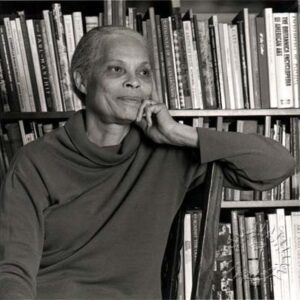


Gwendolyn Knight, New Orleans
Silkscreen on paper
Support size: 22 x 20 inches; Image size: 16 1/2 x 14 1/2 inches 2002
Gwendolyn Knight (1913 – 2005) was an American artist who was born in Bridgetown, Barbados in the West Indies. Knight met Jacob Lawrence in 1934 while they were art students in Harlem, NY and they married in 1941. Throughout their 59 year marriage, Knight and Lawrence were each other’s most valued critic. Knight attended Wadleigh High School, one of the few integrated schools in New York and one with a reputation for good scholarship. She study painting in New York under Augusta Savage, and her first formal study of art came at Howard University, where she studied with the painter Lois Maillou Jones and with printmaker James Lesesne Wells. Like Jacob Lawrence, throughout her career Gwen Knight remained unswayed by abstract expressionism and other trends that moved through the art world.
Though she shared Lawrence’s interest in figuration, her method was more spontaneous and her subject matter more personal. She charted her own creative path in a characteristically independent way. A lifelong artist, Knight supported Jacob’s career, and chose not to participate in art exhibits until 1967. That year, her work was included in “Portrayal of the Negroes in American Painting,” at the Forum Gallery in New York, along with works by Hughie Lee-Smith, Raymond Saunders, Ernest Crichlow, and Jacob Lawrence. In 1971, when Jacob was offered a full-time tenured position at the University of Washington, they moved to Seattle. Knight’s first retrospective was put on when she was nearly 90 years old (“Never Late for Heaven: The Art of Gwen Knight,” at the Tacoma Art Museum, 2003)
In Seattle, Gwen Knight Lawrence became an active member of the cultural community, serving on committees of the Urban League and the Seattle Chapter of the Links, as a member of the King County Arts Commission, and on numerous arts panels and juries. A few years after moving to Seattle, she joined the Francine Seders gallery, which also represented Jacob Lawrence. Knight’s first solo exhibition was at the Seattle Art Museum in 1976. From the mid-1970s onward, her work gained a growing audience and recognition in the Northwest and beyond, with exhibits in venues in Georgia, Oregon, and Washington, D.C. Ms. Knight continued working until 2001, turning in her late work to a series of lyrical mono-prints that captured her interest in improvisation and movement.
During the course of her career, she received many awards, including the National Honor Award, and two honorary doctorate degrees. In 2003, a retrospective of her work appeared at the Tacoma Art Museum and at DC Moore Gallery in New York City, which represents both Ms. Knight and Mr. Lawrence. Gwendolyn Knight Lawrence died in Seattle on February 18, 2005 at the age of 92. Artist Statement “I am not an innovator or an artist concerned with intellectual process I don’t rely on external definitions of success or with the mastery of an other-defined program. I paint for my own pleasure, for the connection it affords to creative life.”
https://eandsgallery.com/product-category/gwen-knight/
12 notes
·
View notes
Text
American fashion designer mom who lived in China for 16 years says she MISSES how Communist government 'co-parented' her children - dictating even what they should eat - and wants U.S. to learn from its example
An American fashion designer who spent 16 years in Shanghai has published an essay in the New York Times highlighting the virtues of raising her children under the watchful and authoritarian eye of the Chinese government.
Heather Kaye, 49, arrived in Shanghai in 2006 with her husband George and planned to stay for a year. But the couple stayed and ended up raising their two daughters there. However, in 2022 the family was driven to return to the US after living for two years under the country's draconian COVID-19 policies.
She has now described her return to Washington DC as a 'culture shock' that makes her miss the way her children were 'co-parented by the Chinese government'.
Yet her own remarks will come as a shock to many who are concerned about the looming threat the Chinese government poses both domestically and to global economics, technology and businesses.
In October last year it emerged that the Communist Party operates secret police stations in New York City to hunt down dissidents force them back to China, while those protesting the country's zero-COVID policy have been known to disappear without explanation. Kaye acknowledged the ways in which the Chinese Communist Party would insert itself into family life, be it by controlling what her kids ate or by dictating the number of hours they should sleep at night.
'In China, government co-parenting begins in the womb,' she wrote, referring to the limits on how many children parents were allowed, which have since been relaxed.
She added that not long after enrolling her kids in state-run schools it started controlling how her kids should live.
'Chinese kindergarten lectured us on everything, including how many hours our daughters should sleep, what they should eat and their optimal weight,' she said.
But she claimed she was grateful for the discipline instilled in her two daughters, born in 2008 and 2010, at school.
She recounted: 'Each morning all of the students performed calisthenics in straight rows and raised China's red flag while singing the national anthem.'
And she commended the Chinese system for independently 'instilling a solid work ethic and a total drive for academic excellence', teaching them that hard work leads to results.
Kaye claimed she was also grateful for the way surrendering parts of their children's lives to the state reduced burdens on her and her husband - and wished American parents might see the value in doing the same.
'I learned to appreciate the strong sense of shared values and of people connected as a nation. Parenting, like governing, is an imperfect art,' she added.Kaye saw merit in Chinese censorship too. 'Raising kids in China was a plus in other ways — such as the heavy censorship,' she wrote.
The government imposed limits on how much time her kids could spend playing video games and it saved them from accessing problematic material on the internet.
Not only that, the state's supervision would keep here daughters safe as they navigated the sprawling, but relatively safe, according to Kaye, Shanghai subway.
In spite of all of this Kaye was driven to leave China, having lived through its zero-COVID approach that confined them for two months to home and limited them to government food rations.
But even as the family left she maintained her admiration for the country and the life they had been able to make there.
In a story covering her family's departure from Shanghai in 2022, she told Reuters: 'Anything you can imagine, you can build it here. Anything you want to be, you can make it happen here.'
A recent report by human rights watchdog Safeguard Defenders revealed that the Chinese Communist Party has at least 54 'overseas police service stations' in 30 different countries, including across the US.
Since the launch of that program in April 2021, China reported that it had 'persuaded' 230,000 Chinese nationals to return home.
The Safeguard Defenders' campaign manager Laura Harth alleged that China has been using it to track down dissidents and force them to return home.

14 notes
·
View notes
Text
Talk Hockey to Me
tagged by @giirlinterrupted 🤍💙
Tell me about:
1. The thing that got you hooked on hockey
I grew up in Lancaster County, Pennsylvania, about an hour south of Hershey, PA. My dad grew up going to watch the Hershey Bears play minor league hockey in the American Hockey League, and he continued the tradition with me (and my sister sometimes.) At first, I only really liked to go to the games for an opportunity to spend time with my dad, which was rare sometimes, but in middle school I somehow ended up being really good at floor hockey when we played it in gym class. One day I managed to score a hat trick, even though I was terrible at every other sport. (I also had a crush on one of the players on my school's hockey team at that point.) So I just kinda thought hockey was fun at that point and started enjoying the actual games more. Then I picked a favorite player from the Bears independently for the first time, and it was Mike Green. I didn't know much about him, just thought he was cool. He turned out to be really good, and when he got called up to the NHL to play for the Capitals, I started watching the Caps games on TV. (I was also lucky that we got the sports channel from Washington DC, despite not being all that close to there.)
2. Your first ever fandom friend
I'm not too established in the hockey fandom on here. I have a personal blog that I rarely use anymore that I used to post occasional Caps stuff on and follow a few Capitals people, but that's on a different account that I rarely use. I know hockey has become a lot more popular on footieblr over the years. I remember a few years back when it was more unusual for these fandoms to overlap that I sent a message or two to people who were in both fandoms that I thought it was cool that they liked both sports like I do. Basically my only hockey friend on here is @giirlinterrupted (and I'm so grateful that she doesn't put Sidney Crosby on my dash like so many other footieblr hockey fans seem to do.) IRL I have been surrounded by hockey fans most of my life though, because it's pretty big in my state in general, so the main time I felt a little more alone on that was the 2 1/2 years I was living in San Francisco. Unfortunately I am currently surrounded by Penguins fans :( as I am living in Pittsburgh. My IRL best friend is also into hockey, but she is a Sabres fan since she is from Buffalo and now lives in Rochester, NY.
3. The jersey you would most like to own
I wish I had an old Mike Green or Jay Beagle Caps jersey. Mike Green is now retired, and Jay Beagle, I don't even know.
4. YOUR player (you only get ONE so choose wisely)
I still have an unhealthy attachment to Jay Beagle even though he's been off the Caps for years. None of the current players can live up to that.
5. A pairing that deserves more fic
Don't really read fic much, but Ovi/Backstrom (I'm so out of the loop that I don't even know if they have a ship name) are adorable together, and idk how popular they are, at least outside of Caps fans.
6. Your favourite on-ice moment

6/7/18. What else?
I still cry when I think about it sometimes, and I can barely listen to "I Will Wait" by Mumford and Sons without crying due to that "Worth the Wait" video the Caps put out on social media after the Cup win.
link someone else's art/fic/etc that you love & think everyone should check out
He's here on Tumblr (@mxgicdave) but I could only find my favorite pic of his on Twitter:

link something you made & are proud of & want people to see
Got nothing. I tried to write a few things about hockey in the past, but not since I was like 13. I was writing a story about a minor league hockey player whose playing got impacted by past trauma. Didn't get very far, then I was also trying to write a murder mystery featuring the Capitals, and I got even less far with that.
no pressure tagging:
I have no one to tag! :(
2 notes
·
View notes
Photo

Speaker Marjorie Taylor Greene :: March 9, 2023
Robert B. Hubbell
On Wednesday, March 8, 2023, Rep. Marjorie Taylor Greene served as the Speaker pro tempore of the US House of Representatives. She sat in the Speaker’s chair as the Clerk of the House read the following proclamation:
“The Speaker’s Rooms, Washington, DC, March 8th, 2023. I hereby appoint the Honorable Marjorie Taylor Greene to act as Speaker pro tempore on this day. Signed, Kevin McCarthy, speaker of the House of Representatives.”
The reversal of fortunes for Rep. Greene is stunning. Just two years ago, Democrats refused to seat Greene on House committees because of her career-long peddling of antisemitic memes and bizarre conspiracy theories. Remember the theory that “Jewish space lasers” were responsible for the outbreak of wildfires in California in 2021?
That was only one of Greene’s outrageous comments. She questions the reality of mass shootings in schools, suggested that planes did not crash into the World Trade Center on 9/11, and promotes QANON beliefs based on the fictitious “Protocols of the Elders of Zion” that claims a cabal of Jews secretly runs the world. There is much more. See Forward, Every antisemitic thing Marjorie Taylor Greene has said.
It would be one thing to bestow a high honor on Greene if she had confessed error and issued a contrite apology for her multitude of offensive statements. Not so here. Just two weeks ago, she was promoting a “national divorce” between “red” states and “blue” states—something that sounds awfully like a “civil war.”
But no statement is too traitorous or offensive for Kevin McCarthy to say, “I haven’t seen / heard / read about that yet.” For example, when asked if he regretted giving Tucker Carlson access to the January 6th Capitol Hill surveillance tapes, McCarthy responded, 'I didn't see what was aired.' An understandable omission given that McCarthy must have taken refuge in a ferret burrow to avoid seeing the devastation wrought by the fire-sale auction of his scruples, dignity, and conscience to secure the Speaker’s chair.
But I digress. While Americans have every reason to be offended by the sight of an antisemitic proponent of a second civil war sitting in the Speaker’s chair, McCarthy’s soul-grinding debasement will come back to hurt the GOP in the next election cycle. McCarthy’s critics said (correctly) that Democrats would use the unedited video of Greene in the Speaker’s chair as a political attack ad. See The Independent,‘Beyond parody’: Outrage after Marjorie Taylor Greene briefly handed Speaker’s gavel by Kevin McCarthy.
McCarthy’s humiliation and the GOP’s descent into Bizarro World are not limited to appointing a secessionist to preside over a legislative chamber that is a hallmark of our national unity. House Republicans began a series of hearings on Wednesday that are the anti-matter equivalent of investigations designed to learn the truth.
For example, a subcommittee investigating the events of January 6th is being led by the GOP Rep. Brian Loudermilk, who famously gave tours of the Capitol to “constituents” on January 5th who photographed stairwells and tunnels in the Capitol, locations not coveted as Instagram-selfie backdrops. Loudermilk says his committee will focus on “security failures” on January 6th.
Hmm. If there was a security failure on January 6th, it might be because domestic terrorists were armed with photos of stairwells and tunnels taken on January 5th during the tour given by Rep. Loudermilk—photos that allowed insurrectionists to quickly navigate to their intended locations in the Capitol.
What are the chances that Loudermilk will explore possible connections between the illegal reconnaissance performed by members of his tour group and the attack on the Capitol? Not good. See PBS Newshour, Jan. 6 panel releases video of Rep. Loudermilk leading a Capitol tour day before attack.
After Marjorie Taylor Greene gaveled the House to order on Wednesday, she made a beeline to attend a GOP committee investigating the federal government’s Covid response. Greene previously compared Covid vaccination requirements to “Nazi’s forc[ing] Jewish people to wear a gold star,” demonstrating that she is ignorant about both the Holocaust and the science of vaccination.
“Up is down, and down is up” in Kevin McCarthy’s kompromat House. I find it difficult to hear these reports and not surrender to anger. But we should recognize that House Republicans are committing a strategic blunder of epic proportions.
They are focusing their investigations on topics that highlight their weak spots and failures—January 6th, Trump's Covid response, and media / tech bias. Those topics are lose-lose-lose for Republicans. The only thing worse they can do is to suggest cutting Social Security and Medicare benefits. Oh, wait, they are doing that, too!
So, let’s not give in to anger or despair. The GOP investigations are self-limiting and self-defeating. And Democrats have demonstrated they have the will and ability to turn the investigations against McCarthy’s blackmailers. We should feel confident and hopeful that Republicans will embarrass themselves and accomplish nothing while Democrats distinguish themselves in the hearings. Given the GOP majority in the House, we can’t ask for much more than that.
#MTG#Outrageous acts#Robert B. Hubbel Newsletter#Robert B. Hubbell#Coup Plotters#anti-democracy#Kevin McCarthy's kompromat house#security failure#anti-semitic
10 notes
·
View notes
Text
I was not academically inclined. Growing up in Michigan in the 1960’s and 1970’s, if you weren’t moving into higher education, you were moving to work on the farm or in the factory. PBB in the feed killed the farmers, and the unions shut down Detroit - everything in the tristate area is premised on Detroit. I graduated high school to nothing but less than minimum wage jobs - if a restaurant makes less than a minimum established profit, they can legally pay less than minimum wage. I graduated at the bottom of my class. I floundered a few years and ended up in the military. I became a Navy Hospital Corpsman and in that, specialized in combat medicine so I served with the Marine Corps. I attended the Naval School of Health Sciences and became an Independent Duty Corpsman. It was a four year medical school program condensed to 56 weeks - accredited by George Washington U. School of Medicine. That program was designed to be a real pressure cooker and had an attrition rate of nearly 30%. Midway through that program, the folks in DC decided to not pay to continue the accreditation. In my class of 27 starters, we had Maurine set the all time high in the history of the school with a perfect score, having never gotten a wrong answer on an exam. We also had Clint who had up to the bitter end, tied Maurine but then got one wrong answer. Me? I graduated dead last in that class with a GPA of 90.63.
Maurine was relieved for cause within three months of graduation. She cracked under pressure. Clint was relieved a little over a year after graduation, hooked on pain killers. During our school year, due to failures in exams and also due to cheating, we were whittled down to 14 and boosted up again to 25. At the end of the first three years of duty, only 5 of us remained as IDC’s.
My final tour had me in line to head up the clinic at Camp David. I refused the orders and was then informed that I’d been asked for by name by the President. Again, I turned down those orders and retired out of Camp Pendleton, where I worked out of three different clinics and was responsible for all of 3d Marine Air Wing.
With the exception of performing surgery and doing the paperwork shuffle, I truly enjoyed practicing medicine without benefit of an actual doctor staring over my shoulder. I did 20 years and then retired. I was delusional in believing that I would be welcomed with open arms at the university where I could take my 146 credit hours mostly in upper level sciences and could step into a civilian program. I was not and instead had to take a basic first aid course where we all learned that I was more qualified than the “doctor” instructing that course. Frustrated by the greed and stupidity, I graduated with a degree in History.
A worthless degree, absolutely no one would hire me. Not the county school system, not the air museum, not a local construction firm. Not any of the big box hardware stores and certainly not any of the four major hospitals or even a company doing insurance physicals. With a wife, 3 children and a mortgage for a 4 bedroom house on 10 acres, I was fast running out of money.
When no one else would hire me, I hired myself. We opened a dog grooming business. We started that business with less than $5,000 in the bank. I was accustom to working 16-18 hour days and that’s about what it took. We busted our butts, my wife and I, and after the 1st 5 years, we were able to be competitive. We shut down every other groomer in the north end of the county and found ourselves under cutting the big box pet stores that also offer grooming at premium prices. Literally, I went from being an elite (less than 1,000 in the entire Navy and Marine Corps) healthcare provider to petting dogs for a living.
With a whole lot of sweat equity, we were able to build our business into a 6 figure income and had to hire outside help to keep pace with the demand. We hire unskilled, untrained labor and we start at $14 an hour. We train, starting with the basic life skill of negotiation. I blame public “education” for the mess this country is in. At best, they teach you to sign your name on the bottom line. They do very little to prepare any of us for the world. They certainly do nothing to prepare us for making responsible, informed decisions of consent.
I own the business meaning, I own outright, the means of production. As an employee, you agree to do a specified job for a given amount of money. These things, you, the employee, agreed to. Now, the beautiful thing about the free labor market as opposed to the left’s slave labor market, is that if at any time you are dissatisfied with the terms of your employment, you have options. You can either step up your game and try to negotiate a better position for yourself. Or, you can serve notice of intent to terminate and then seek your fortune elsewhere.
Personally, given my history with experience in both public and military education, I recommend being a forward thinker. Start by studying fact based history and learn to exercise critical thinking skills. Learn politically who you can rely on as a “friend” and who is in it purely for themselves at your expense - it’s not whom you were told all of your life. Vote accordingly and work to change the education system. At present even those sho graduate at the highest levels of the upper stratosphere, slave for someone above them. Read the last 128 pages of de Tocqueville’s Democracy In America”. Understand that he published this in 1833 when race based slavery was still legal.
2 notes
·
View notes
Text
The River School has spent years refining its research-based, child-centered approach to teaching. The basis of our educational philosophy is grounded in the pillars below. Ultimately, our goal is to help children find their voice and thrive.
#independent school washington dc#private school washington dc#independent private school washington#private independent school washington dc
0 notes
Text

Is that MIMI MADISON-BHATT? A SOPHMORE originally from WASHINGTON, DC, they decided to come to Ogden College to study Linguistics & Environmental Studies. They’re THE AMATEUR SLEUTH on campus, but even they could get blamed for Greer’s disappearance.
pinterest | connections |
BASIC STATS
Full Name: Meera Hana Madison-Bhatt
Nicknames: Mimi (what she prefers to go by), Mads
Date of Birth: December 1st, 2002
Hometown: Washington, DC
Nationality: American
Ethnicity: South Asian Indian
Western Zodiac: ☼ Sagittarius | ☽ Scorpio | ↑ Virgo
Sexuality: Pansexual
Relationship Status: Complicated
Socioeconomic Status: Rich
Occupation: She runs a side hustle investigating for students on campus.
PERSONALITY
FOUR POSITIVE TRAITS: Passionate, Optimistic, Intellectual, and Independent
FOUR NEGATIVE TRAITS: Emotional, Stubborn, Blunt, and Argumentative
THREE SKILLS: Investigating, Hacking, & Stealth
Moral Alignment: Neutral Good
MBTI: ISTJ The Logician
On the Outside, Mimi is a talkative, animated, and guarded person. She skips small talk to bluntly ask why you’re talking to her. Mimi doesn’t share much about herself, rarely trusting anyone. However, she gives people the benefit of the doubt until she is proven otherwise. Mimi is easily excited by the prospect of a mystery, going on about theories and potential clues. She tends to go on about things she is interested in until someone tell her to be quiet. Depending on tone, she will either smile and stop or start arguing about your rudeness.
On the Inside, there’s a lot of inner turmoil. She wants to be a positive, intelligent, and uplifting person, but past experiences make it difficult to be this person. Mimi wants to believe good is out there, but it’s hard to trust when all you’ve seen is bad.
FICTIONAL CHARACTER INSPO
Sherlock Holmes (Sherlock), Stiles Stilinski (Teen Wolf), Betty Cooper (Riverdale), Shawn Spencer (Psych), Abby Sciuto (NCIS), Dustin Henderson (Stranger Things), Tyrion Lannister (Game of Thrones), Penelope Garcia (Criminal Minds), Alli Bhandari (Degrassi: The Next Generation)
STUDENT FILE
School Year: Sophomore
Major: Linguistics
Minor: Environmental Studies
Sports: Ballroom Dance Club, Dance Team, Ballet Company
Extracurriculars: Mental Health Union, Debate Team, &
Kappa Kappa Gamma Member
FAMILY
Father - Everett Madison
Father - Samar Bhatt
Grandmother - Agatha Madison
Grandfather - Alexander Madison
Grandmother - Uma Bhatt
Grandfather - Kanan Bhatt
Older Brother - Rohan Madison-Bhatt
Older Brother - Charles ‘Charlie’ Madison-Bhatt
Older Brother - Sutton Madison-Bhatt
Older Sister - Laura Madison-Bhatt
BACKGROUND
Meera was adopted when she was four years old by her fathers, Everett Madison and Samar Bhatt. Samar and Everett work for the Federal Bureau of Investigation. Samar works in human trafficking department, while Everett teaches classes, and does some work with cyber crime division. Samar had a bust with his division, saving dozens of people, but the little girl who clung to him and refused to let go was a victim he couldn’t send away.
At the time, Mimi was their third child. Her two, older adoptive siblings, Rohan and Laura started there. Both of them started off as foster care children, whom the Madison-Bhatt’s adopted. Charles was adopted two years after Meera. Sutton was last, adopted when she turned seven.
Her grandparents played a heavy role in her upbringing. Both her fathers’ jobs have them working long hours, but did not want to rely on a nanny to raise the children. The Madison side of the family is old money. They spoiled the children, but taught them the power of wealth and how to navigate the world. The Bhatt provided Mimi a chance to know her culture. Her parents took Rohan and Mimi on a yearly trips to India for them to learn more about their heritage.
Mimi was enrolled in dance lessons at the age of eight after she told her dad she wanted to look like the pretty ballerinas in the Barbie movies she watched. She started off doing ballet, but found herself loving every style. Mimi trained in multiple types. Her favorite styles are ballet, jazz, and Latin. She is considered classically trained and has won every competition she competes in.
Tragedy befell the family when Sutton died at the age of nineteen. It hit Mimi especially hard, due to their closeness. Their family rallied together, going to therapy and supporting each other through it all. They healed, but not without effects.
She dreams of being just like her parents and getting involved in the FBI. Her goal is to work internationally, which encouraged her love of languages. Ogden boasted providing the best program for her career path so it seemed like a perfect fit.
Initially, everything was going super well. Mimi got involved and met plenty of potential friends. Then she met Greer Morrison. She tormented her, making every second she spent on campus hell on earth, and forced many people on campus to join in as well. Mimi thought about transferring multiple times, but she refused to let Greer think she beat her. Coming into this year and seeing that Greer isn’t around, things have begun to look up. The investigation wasn’t a shock to her, but it does have her guard up.
THEIR RELATIONSHIP WITH GREER - Greer’s Victim
When Mimi first arrived at Ogden, she didn’t expect to become enemies with the Queen Bee. It started off as rude remarks and glares from across the room. It would escalate into being excluded from events and cruel comments on her social media. It was her mission to make Mimi miserable at Ogden, and she almost succeeded. She never had any proof it was Greer behind it, but she knew. Greer going missing, while peaceful, has Mimi scared that she will be the next suspect. However, a big part of her wonders why Greer hated her in the first place.
HOW THEY EMBODY THEIR TROPE - The Amateur Sleuth
As a child, Mimi adored the mystery stories her father would read with her. There was something about gathering clues and information to reach a final conclusion that intrigued her. She found her nose constantly in a book, trying to solve the case. It wasn’t until middle school that Mimi realized she could do it in real life! It started off simple: the case of who stole the fruit roll ups, missing homework, the little things. She enjoyed the thrill of finding the culprit. She eventually turned it into a business. Is my partner cheating on me? Yes, and she’s got the evidence to back it up. Which faculty is on the committee for homecoming court? She’s got their names and addresses. At Ogden, she’s managed to keep this little business running well without any of the faculty finding out. One of the perks of being an outsider. Greer’s missing person case is the perfect time to show that she can handle something more intense.
MISCELLANEOUS/HEADCANONS/RANDOM THOUGHTS
Mimi has her pilot’s license, and a Cessna 172 Skyhawk she shares with her family.
Her grandmother, on the Madison side, and older sister were in Kappa Kappa Gamma.
She prefers the Hardy boys over Nancy Drew.
Mimi loves botany, and is obsessed with the language of flowers. Her dorm is filled with plants.
She speaks four languages: English, Hindi, French, and Spanish. She is currently studying Latin.
Tea is her caffeinate drink of choice.
Huge Game of Thrones fan: books and tv show.
A major Swiftie.
Mimi has a Tik Tok account where she does popular Tik Tok dances, dance tutorials, and blogs a bit.
Any weather is sweater weather.
Mimi has a bicycle on campus that she uses to get around.
She is a gamer, specifically Call of Duty. Like most of the internet right now, Mimi is a simp for Simon "Ghost" Riley.
#➳not all tears are evil ➳#ogdenintro#mimi madison bhatt#amateur sleuth#tw human trafficking#tw death
3 notes
·
View notes
Text
Primary 1 English Enrichment Class and Best English Class For Primary 1 - Creative Learning
In Washington, DC A nonprofit organisation, Creative Learning, Since its creation in 1977, Creative Learning has supported communities, non-governmental organisations, and educational institutions both at home and abroad in their efforts to bring about change that has a significant long-term social impact.
The potential of regional organisations to improve the lives of local citizens everywhere is strengthened by Creative Learning's focus on areas where there are pressing human needs. Establishing people-to-people partnerships is a particularly effective way for us to uphold human rights, advance social and economic development, and foster peace.
A new teaching and learning methodology (TLM) named "Creative Learning" was created by APCL with the goal of fostering an individual's creativity. Every child is creative from birth, according to the school. Development of the child's intrinsic learning processes is the system's primary goal. It makes an effort to cultivate seven fundamental skills known as Core Creative Competencies (C3): focus, power of observation, memory, thinking, imagination, emotional control, and communication/expression power. ([4] Although it incorporates them into contemporary educational systems, the system is founded on conventional Yogic cultural practises.
Click Here: Best Primary English tuition centre in Singapore
Every child receives individualised instruction according to his or her personality, family, and social surroundings. The contents are regularly adjusted to the child's strengths by using monitoring and evaluation.
Offering English enrichment classes and writing programmes for primary school pupils makes Creative Edge Learning proud. All of our students will leave our English and creative writing sessions with the necessary information and abilities to succeed in Singaporean examinations creative writing classes for primary schoo, Singapore . Additionally, in a collaborative and dynamic learning atmosphere, our professors will share advice on how to improve both analytical and creative thinking. Your child gradually learns and masters the language and writing skills through a continuous progression across the six primary school levels.
Your child gradually learns and masters the language and writing skills through a continuous progression across the six primary school levels.
Our programmes assist your kid in learning at every stage of their primary education, from being eager learners in the lower primary years to independent learning in the middle primary years to finally mastering the language in the upper primary years.
Why is creative learning important?
Learning experiences that are imaginative elicit strong student engagement. Learners retain information longer and develop their understanding when they actively participate in the process. However, that is only the beginning. The benefits of creative learning go far beyond that.
It encourages creative problem-solving.
Learning activities that are creative alter how students approach issues. They develop greater creativity and innovation, as well as an improved ability to manage uncertainty. Creative learners begin imagining alternatives or possibilities from several angles. They can anticipate and overcome challenges thanks to this change in perspective.
Strengthens critical thinking.
Students put up original solutions and ideas. The process is then improved by reviewing how well they've implemented them.
encourages taking risks Learners who engage in creative learning run the risk of failing. They have the option to make judgments, some of which may unavoidably fail to produce answers. However, engaging in creative learning gives students a setting where they can experiment and discover new things. Gaining confidence in "failure" enables students to take more risks while feeling less anxious.
It creates an attitude of curiosity. Unconventional approaches to education are creative. Unusual teaching methods stimulate interest in the subject and the learning process in students and encourage learning in general. Curiousity, conversation, and fascinating discoveries are all fostered by creative learning.
Boosts one's sense of assurance.
Confidence-building learning strategies are creative. As a result? Lessons learned are more likely to be applied by students.
For more info click here: Primary Composition Writing Classes
#Primary 1 English Enrichment Class#Best English Class For Primary 1#Primary 2 English Enrichment Class#Primary 3 Creative Writing Class#Primary 3 Composition Writing Class#Primary 4 English Writing Class#Primary 4 English Class#Primary 5 English Class#Creative Writing Classes For Primary School Singapore#Primary Composition Writing Classes#Primary English Classes Singapore#English Tuition for Primary 1 Singapore#Creative writing for Primary two Singapore#English tuition for Primary 2 Singapore#English tuition for Primary 3 Singapore#Primary 3 English enrichment class Singapore#Creative writing enrichment classes Singapore#English enrichment class for primary Singapore#Best Primary English tuition centre in Singapore
2 notes
·
View notes
Text
Gladys Nelson Smith (1890-1980) pintora estadounidense.

Nacida en El Dorado o Chelsea, Kansas, fue una de diez hijos.
Estudió arte en la Universidad de Kansas, de la que se graduó en 1918.

Su esposo, Errett Smith, fue reclutado, por lo que se mudó a la ciudad de Nueva York para esperar su regreso. Allí tomó lecciones en la Art Students League de Nueva York.


Continuó sus estudios en el Art Institute of Chicago y en la Corcoran School of Art, donde sus maestros incluyeron a Edmund C. Tarbell y Richard Sumner Meryman, Sr. Permaneció en el área de Washington, DC por el resto de su vida, tomando clases en la Corcoran hasta 1930.

Durante su carrera, expuso con la Society of Washington Artists y mostró su trabajo en las Bienales de Corcoran. En las exposiciones de la Sociedad de 1936 y 1939 recibió premios populares; en 1929 recibió una medalla de bronce.

Exhibió varias obras en la Greater Washington Independent Exhibition de 1935, y en 1939 formó parte de una exhibición con el Landscape Club of Washington. Exposiciones individuales de sus pinturas se llevaron a cabo en 1979 y 1984-1985, esta última en la Corcoran Gallery of Art.
Su obra ha sido descrita como impresionista.

En 1936, ella y su esposo compraron una granja cerca de Frederick, Maryland como un retiro de fin de semana, y esto le proporcionó la fuente de la que encontró mucho material. Vivieron en Chevy Chase a partir de 1949. Su esposo murió en 1974.

Ella se mudó a un asilo de ancianos en Kensington, Maryland al final de su vida, y murió allí después de una batalla contra la enfermedad de Parkinson. Le sobrevivieron dos hermanas.
Le ponemos cara con sus Autorretratos.


0 notes
Text
In Memoriam: A Eulogy for Professor Walter J. Petry Jr.
Professor Emeritus Walter J. Petry Jr. died on August 13, 2024, at the age of 92. The first Black professor to join the faculty of Fairfield University, Professor Petry taught history in the College of Arts and Sciences for 48 years, from 1957 to 2005. He served as inaugural director of the Latin American and Caribbean Studies program and received the Martin Luther King Jr. Vision Award in 2003.
Donations in memory of Professor Petry’s many contributions to the University community may be made to the Fairfield Bellarmine Fund.
By Lee Penyak ’84, PhD

Photo: Professor Walter Petry teaches class on "Modernization in the West."
Walter J. Petry Jr., professor of history at Fairfield University from 1957 to 2004, died on August 13, 2024, at the age of 92. He was the only child of Walter J. Petry Sr. and Lois Petry (née Gairy). His father moved from New Iberia, Louisiana, to New York City in 1921. His mother’s parents, originally from the Caribbean islands of Grenada and St. Kitts (now both tiny independent nations), settled in New York in the late 19th century. Walter Petry Sr. worked for several years in the U.S. Postal Service, was one of the founders of the Catholic Layman’s Union of New York, and, in 1989, received from Cardinal John O’Connor the prestigious Pierre Toussaint Medallion – awarded to a member of New York City’s Black community for demonstrating an active commitment to freedom, human rights, and spiritual values. Lois Gairy graduated from Hunter College in 1930 with a major in Latin and Greek, and eventually taught English, earth science, and mathematics to junior high students in the New York City Public Schools system for many decades. To a significant extent, Professor Petry followed in his parents’ footsteps by combining their commitment to education and social justice into an extraordinary academic career at Fairfield University that spanned nearly 50 years.
Born on June 30, 1932, Walter Jr. and his parents first lived on the top floor of a brownstone with extended family on East 130th Street in Harlem. Among his earliest recollections and frustrations was working on his basic Lionel train set which needed to be equipped with a transformer to allow the AC locomotive engine to run on the DC current then dominant on Manhattan’s East Side. In 1943, his parents bought an 1890 brownstone on 418 West 160th St. in Washington Heights which had a magnificent view of the Morris-Jumel Mansion, Manhattan’s oldest (1765) surviving residence. Walter lived with his parents, maternal grandfather, and aunt (his mother’s sister, Aunt Dorie) and was proud to call 418 home for the rest of his life. When reminiscing about his dwindling childhood in the Heights, he mentioned being walked by his mother to school, taking the five-cent subway ride by himself once he turned 13, and the historic 25-inch snowstorm on December 26, 1947, that allowed him to sleigh ride from the bottom of his stoop to Edgecomb Avenue. Walter spent parts of every summer until he was 16 years old at the Catskills home of his beloved godmother Harriet Baltimore. Daily hikes instilled in him a deep appreciation for nature and advocacy for the protection of the environment.

The Petrys were members of the Church of St. Joseph of the Holy Family on West 125th Street and Convent Avenue, and traveled there by subway for Sunday Mass. Now known as a Catholic church with mostly Black parishioners, the parish was originally established for German Catholics and had become predominantly Irish by the 1940s. St. Joseph’s parochial school accepted Walter as a student in 1938 (he had been denied entrance at other parochial schools in upper Manhattan and the Bronx based on race) and he studied there until graduating from eighth grade in 1945. He recalled being one of about six Black students in the graduating class of 30. He was a member of the small student choir that sang daily Mass before school, and he kept his books of Gregorian chants as prized mementos.
Before graduating from grammar school, Walter took a competitive exam and earned admission and a scholarship to attend Manhattan Prep in the Riverdale neighborhood of the Bronx, about four miles north of his home on the Number 1 IRT Subway. This school (closed in 1971), run by the Christian Brothers, a Catholic religious teaching congregation, emphasized the liberal arts and a commitment to Christian ethos as envisioned by its founder St. Jean-Baptiste de la Salle (1651-1719). Walter always exaggerated saying he spent more time tackling the challenging readings he was assigned in high school than he did as an undergraduate student. He admired his intimidating and demanding teacher of physics, Brother Alphonsus, and the equally difficult and engaging teacher of English and history, Charles Winans, who also served as moderator of the school’s forensic team, where he pushed Walter to become an effective debater. Walter ran cross country in the Van Courtland Park flats and woods and the half mile as a member of the indoor track team.
Walter made the seamless transfer from the Prep to Manhattan College by walking across campus in September 1949. Beginning that year, Manhattan implemented an experimental four-year core curriculum for students in its liberal arts school focusing on literature, history, philosophy, and fine arts during the ancient world (year one), the medieval period (year two), early-modern Europe (year three), and the 20th century (year four), with additional coursework dedicated to a student’s major — mathematics, in Walter’s case. Manhattan’s faculty quickly recognized the dearth of important coursework in the hard and social sciences and promptly initiated curricular changes for all subsequent students of the liberal arts. The 35 members of Walter’s cohort of 1953, however, stuck to the original four-year plan. Despite flaws in its design, Walter eventually considered that unique pedagogical approach critical to his intellectual and professional formation. He particularly enjoyed the history courses taught by Brother Gabriel, PhD, and Dr. Morrison Swift, and credited them with helping him decide to pursue an advanced degree in history.
The Korean War (June 1950 – July 1953) corresponded to Petry’s undergraduate years at Manhattan College; he and his fellow students had received deferrals before graduating. Once he graduated in May 1953, he was promptly inducted into the U.S. Army and served stateside until June 1955, first being sent to Camp Kilmer in New Jersey and then completing basic training at Camp (now Fort) Gordon in northwest Georgia. His most vivid memories of Camp Gordon were the never-ending mounds of mud in which he trained and his difficulty completing the number of pull-ups required to pass. Notwithstanding these challenges, he enjoyed getting into the best physical shape of his life and meeting young Americans from all over the country. After basic training, he was sent to Fort Sam Houston in San Antonio, Texas, where Petry and other privates were assigned KP duty, usually washing mess trays if they arrived early and garbage cans if they arrived on time. He made it a point to arrive early. After being promoted to corporal, he worked exclusively as a clerk in the medical service corps. Walter and other members of his unit took advantage of San Antonio’s proximity to Mexico to travel by bus to Nuevo Laredo, Tamaulipas, where they spent a few days eating delicious “foreign” food, exploring neighborhoods, and trying to converse in Spanish with the local population. This would be his first foray outside the U.S. and seems fitting since he would later become deeply interested in Latin American history.
Walter completed his military service in June 1955 and that fall began the master’s program in European History at Columbia University. There, he especially enjoyed classes taught by Jacques Barzun and Garrett Mattingly. Barzun’s publications and the courses he taught focused on European ideas and cultures and emphasized the themes of power, ideology, class, and race, synthesized in his From Dawn to Decadence: 500 Years of Western Cultural Life, 1500 to the Present. Mattingly had recently published Catherine of Aragonand Renaissance Diplomacy and was finishing his brilliant manuscript, The Defeat of the Spanish Armada.
In 1957, with his master’s degree in hand, Walter contacted several universities within commuting distance from Manhattan, including Fairfield, which had only been in operation for fifteen years and which Walter had never heard of prior to applying. He was delighted to be asked to join its faculty and commenced his nearly five-decades' routine of commuting to Fairfield via the New Haven Line every Monday morning, walking from the train station to Canisius Hall, up and down Bellarmine Road daily to his rented room near the University, and then back to the train station each Friday evening for the return trip to the city. (He never learned to drive and bragged to others — who frequently shuttled him to and from important engagements — that, as a New Yorker, he had no need for a driver’s license or a car.) As a new history teacher at Fairfield, Walter taught four sections of basic Western Civilization each semester. Upper-level European history classes at the time had usually been taught by Francis A. Small, S.J., but when he was tasked with directing the library and moving the main collection from Xavier Hall to Canisius Hall (where it remained until 1968), Walter was given the opportunity to teach courses on the Renaissance, the Reformation, the Enlightenment, and Romanticism. Fairfield’s history department was decidedly Euro and Americentric during Walter’s first two decades; changing times and student prompting slowly convinced the department to diversify its offerings. In the late 1970s, James Murphy, S.J., chair, asked Walter to consider a reduced courseload to take classes in Latin American history at Yale University with a view toward teaching the same at Fairfield. Walter accepted the challenge and traveled to Yale every Monday for a year to study under renowned Brazilian historian Emilia Viotti da Costa, famous for her work on slavery and abolition. Henceforth at Fairfield, Walter became most known as its Latin American historian. Until his retirement in 2005, he regularly taught courses on Latin America’s colonial and modern periods and frequently served as faculty historian on seminars offered by the Program in Latin American and Caribbean Studies, which he periodically directed. As professor emeritus with expertise on church and politics in Nicaragua, he was frequently invited as a guest speaker in classes where he continued to entrance students by his lively performances.
Petry was a demanding, inquisitive, intimidating, animated, and unforgettable teacher. Forever fascinated with ethnicity and family origin, he frequently referred to students solely by their surname. One needed to arrive to class prepared since Petry did not suffer fools lightly. His lengthy and challenging readings for class — mostly primary sources — forced students to analyze on their own and think independently. It wasn’t uncommon for students to spend an entire class examining two or three sentences from a single document.
Read it again,” he would bellow, after a student made a feeble attempt at analysis. “Okay, you’re getting there, but what’s the author really saying?” His follow-up questions might include: Does the author have an agenda? What school of thought does he belong to? Who is the intended audience? What’s the author conveniently leaving out? What would his detractors say? One’s head hurt from thinking so much after a Petry class. He received Fairfield’s Distinguished Faculty Award in 1983 a Distinguished Teaching Award in 2004.
Petry also made his presence felt outside the classroom. Students from the ’60s and early ’70s will particularly remember his role in seminars, protests, and sit-ins against U.S. involvement in the Vietnam War. He helped lead the (unsuccessful) charge against the granting of an honorary degree to Secretary of State Alexander Haig in 1981. At university events he frequently brought attention to repressive military dictatorships and structural violence in Latin America and to U.S. interventionism and revolutionary regime change in that region. Fairfield student newspaper articles from the 1950s to the 2000s regularly mention him and include letters to the editor written by and about him.
Petry was an inveterate traveler. Summer vacations found him visiting the British Isles, western Europe including Spain after Franco died in 1975, and many Latin American countries, including Cuba, Haiti, Mexico, Guatemala, Costa Rica, Ecuador, Peru, Bolivia, and Brazil. He made his first trip to Nicaragua in July 1981 to observe the second anniversary of the Sandinista triumph and visited the country annually from 1983 to 1992. He methodically collected and preserved materials of the Sandinista revolutionary project for analysis by future scholars. These documents, journals, newspapers, propaganda, posters, and photos now form part of the “Walter J. Petry Collection—Nicaragua: The Sandinista Years (1979-1990)” at the DiMenna-Nyselius Library. He donated some 400 books from his personal collection to the library’s main collection.
Petry was co-editor of two Orbis Books on religion in Latin America. The first book, Religion in Latin America: A Documentary History (2006), won 1st Place in the category of “Reference Work” by the Catholic Press Association. The second book, Religion and Society in Latin America: Interpretive Essays from Conquest to Present (2009), contains his provocative co-authored chapter titled, “The Right to Appropriate, The Duty to Evangelize,” which analyzed the core set of assumptions that 16th-century Iberians brought with them to the New World. His final publication, “Roman Catholicism in Latin America,” appeared in Encyclopedia of Latin American Religions (2019) and includes valuable sections on church-state relations during the long 19th century and the emergence of a reinvigorated church since the middle of the 20th century. Petry examined topics he cared about: the human tragedy of captured and enslaved Africans, the misery and desperation of the poor, the recalcitrance and belligerence of elites, and defenders of human rights such as António de Vieira S.J. (1608-1697), Hélder Pessoa Câmara (1909-1999), and Samuel Ruiz (1924-2011). His complex prose sometimes made emotional appeals. For example, when writing about Gustavo Gutiérrez O.P. (b. 1928), the “father” of Liberation Theology, he provided the following contextual analysis and questions: “What does the Christian minister (of any denomination, time, or place) mean when he/she proclaims, ‘God loves you?’ Are not the implications of that apparently simple message that each person is worth something, has dignity, can free him or herself from base instincts, is capable of achievement, even transcendence, and is certainly capable of freeing him/herself from the snare of ‘sin,’ that is, self-indulgence, selfishness, and isolation? But is not this also true of one’s neighbor, and of all ‘neighbors,’ i.e., the entire human community?” (2006, p. 272).
Walter forged strong personal and professional relationships with former students and colleagues who could count on him for advice and wonderful tours of Manhattan. He enjoyed sharing meals and traveling with them, and appreciated the innumerable times friends chauffeured him to and from events. He spent his retirement years in much the same way he tried to spend his weekends while still teaching at Fairfield. The perfect day would have included a thorough reading of The New York Times, listening to classical music, such as cantatas by Bach (whom he considered music’s greatest genius), harpsichord compositions by Rameau, chamber music by Schubert, and nearly anything by Handel, Mozart, and Beethoven, then going to an independent movie theater to see an alternative or foreign movie he boasted could only be seen by New Yorkers, followed by a late lunch or early dinner at an Indian restaurant on East 6th Street (“take your pick, they’re all good,” he’d say), and topping off the day by seeing an opera by Mozart at The Met where he had a subscription for a seat in First Row, Balcony.
To honor Walter’s many contributions to the University community, please consider donating in his memory to the Fairfield Bellarmine Fund on the university’s website at Fairfield.edu/bellarmine-give.
0 notes
Text

For all those who need to know:
The Three Branches of the American Government (since 1851) are: (1) the Union of States dba The United States; (2) the Federation of States dba The United States of America (Unincorporated); and (3) the Confederation of States of States dba the States of America.
The Three Branches of the Federal Government are: (1) the States of America (American, Unincorporated); (2) the United States of America, Incorporated (British Territorial, Incorporated); and (3) the United States, Incorporated (Holy Roman Empire, Incorporated).
Recently, we have received a "warning" telling us that "all three branches of the government" ---- "executive, legislative, and judicial" --- are a "captured operation".
This is because Americans were misled through the so-called Public School System to think of the Three Branches of Government in terms of functions instead of thinking in terms of discreet, identifiable business entities.
This was done to obscure the actual meaning of "three branches of government" and thus used to deceive people and explain away earlier references to the three branches of the American Government and the three branches of the Federal Government, too.
In the same way, our country's capitol has always been Philadelphia, Pennsylvania, but the Federal Capitol founded in the District of Columbia has been used to upstage it and focus attention on the foreign Congresses and foreign international and global Subcontractor operations located in Washington, DC, instead.
This is part and parcel of a long history of using semantic deceit to obscure the meaning of language and redefining words as legal terms--- for example:
1. Redefining "person" to mean "corporation";
2. Redefining "natural person" to mean "corpse";
3. Using "emancipation" of slave owners to sound like emancipation of slaves;
4. Calling states-of-states "Confederate States";
5. Describing the Federal Capitol as "the" Capitol-- as if there was only one capitol city associated with our country;
6. Using "enfranchisement" as a corporation as if it was synonymous with voting rights;
7. Using "Uniform Code" to define "Uniformed Officers";
8. Registering physicians as "Medical Doctors";
9. Registering lawyers as "Bar Attorneys";
10. Using titles "Mister", "Miss", "Missus", etc. to address average people who are not in the British Merchant Marines or Navy;
11. Using the title "Taxpayer" (a British Warrant Officer who collects taxes for and transmits them to the King's Treasury) as if this meant just anyone who owed a tax;
12. Deliberately confusing The United States of America (an unincorporated American Federation of States) with The United States of America, Incorporated, (a British Territorial corporation registered in Scotland in 1868);
13. Using the word "voter" as if it was synonymous with "shareholder";
14. Using "motor vehicle" as if it was synonymous with a private auto not being used for commercial trade;
15. Using the word "driver" as if it was synonymous with the operator of a private, non-commercial auto;
16. Using the word "federal" to obscure its synonym "contract";
17. Calling an experimental mRNA injection a "vaccine";
18. Calling an American who works for the Federal Government a "non-resident alien";
19. Confusing United States District Courts (Territorial Courts) with district courts of the United States (formed under Article V).
20. Calling U.S. Territories and Possessions "Insular States" and promoting the idea that there are 57 "States";
21. Confusing British Territorial Franchise Corporations operating as States -of- States, for example, "the State of Texas", with Texas, the State;
22. Calling a foreign sovereign bank account in the International Monetary Fund the "United States Treasury Department";
23. Calling a foreign private banking cartel the "Federal Reserve" as if it was part of our Federal Government;
24. Calling a foreign, independent subcontracting agency the "Federal Bureau of Investigation" as if it was an integral part of our Federal Government;
25. Calling American Nationals "U.S. Citizens" and secretly registering them as such;
26. Passing off clearinghouse certificates as "Baptismal Certificates" and "Birth Certificates";
27. Calling American Nationals "citizens of the United States" and secretly registering them as such;
28. Pretending that "registering" property is the same as "recording" an interest in it';
29. Redefining "marriage" as a commercial Joint Venture;
30. Redefining "children" as "production units" of such a "marriage";
31. Coining disparaging labels like "sovereign citizen" which is an oxymoron and total gobbledygook.
We could go on but we've made our point. A long term and concerted effort has been made to obscure, confuse, substitute, and otherwise "gloss over" the common meaning of names, words, phrases, and legal terms to promote hidden meanings and unconscionable contracts, to unlawfully convert material interests, to obtain insurance advantages and to promote illegal actions, especially illegal asset confiscations, under color of law,
As for the three functions --- executive, legislative, and judicial, these are common functions of all three Federal Subcontractors and our American Government, too. Substituting these functions of government for the actual subunits of our government and calling them "the three branches" is a liberal misunderstanding of what the traditional and customary "branches" of our government, American or Federal, are.
The American Union of States is an unincorporated Holding Company holding the Mutual Powers at the National (Soil Jurisdiction) level of our American Government. The members of this Union are called "Union States" (nothing to do with the so-called Civil War "Union") and they are composed from all the counties within the borders of each Union State.
The American Federation of States is also an unincorporated Holding Company holding the Mutual Powers at an International (Land and Sea Jurisdiction) level of our American Government. The members of this Federation are called "States" and they are each complete and unitary within their State borders.
The American Confederation was also an unincorporated Holding Company holding the Mutual Powers at a global (Air Jurisdiction) level, prior to losing a quorum of members to operate in April of 1861. Its members were unincorporated American Businesses called "States of States" or "Confederate States" all operating in the realm of global commerce.
These are the "three branches" of our traditional and customary American Government; a careful Reader will discern that only two out of three of these Common Law branches are functioning now -- the Union States which are built upon our County Assemblies, and our Federation States built upon our American State Assemblies.
Even now, we have a problem with District Territorial and District Municipal "Assemblies" trying to conduct our business "for" us, and usurping powers never delegated to them. We also struggle with foreign British Territorial State-of-State corporate franchises misrepresenting themselves, cashiering our assets in non-obligatory State Trusts for use as collateral slush funds, and constantly trying to subject us as part of their own foreign citizenry.
These difficulties are to be expected after a long lapse of activity on the part of the sovereign government, but are, nonetheless, being slowly overcome as a clear understanding of the situation spreads worldwide and more people realize that the "federal" government, meaning "contract" government --- is not the actual government of this country, but is instead composed of two foreign service providers organized as corporations in the business of providing "essential government services".
Just as only two out of three branches of our American Government are now functioning, only two out of three branches of the intended Federal Government are now functioning.
This circumstance arises out of the same cause --- the loss of the original Confederation, due to lack of quorum.
The Confederation operating as the States of America was awarded the first Federal Constitution in 1787 --- The Constitution for the united States of America --- and it ran the first Federal Subcontractor known as "the Federal Republic" as an American governmental services provider from 1787 to 1861.
When the American Confederation went down, it took the Federal Subcontractor it sponsored with it.
Thus one branch of the three American Government branches was rendered inoperable and one branch of the Federal Government was rendered inoperable, at the same time, with the same stroke.
This circumstance then allowed Mr. Abraham Lincoln to claim that an "emergency" existed within the Federal Government, and to assert an obligation by the British Territorial Subcontractor to impose military control and ensure "continuity of government" --- the same exact reasoning being used by Donald Trump today.
It was under these presumptions that Lincoln created the infamous Rump Congress of hand-picked British Loyalists and placed them in the vacated Congressional seats of the Southern Delegates -- and from there, used this mixed body of elected Northern members and substituted Southern members to prosecute the so-called American Civil War.
But was this presumption justified on Mr. Lincoln's part --- or Mr. Trump's?
The actual States making up our Federation of States were not in Session when the original Confederation collapsed, but they could have been called into Session by Mr. Lincoln. He chose not to call upon his Employers for assistance, but it is self-evident that: (1) he owed them the duty to fully inform them and engage them, and (2)
If Lincoln had done so, the Federation of States that had delegated all federal powers -- including Mr. Lincoln's -- had the primary right and power to resolve the situation and provide the services normally entrusted to the Federal Republic by other means.
There would have been no "emergency" within the Federal Government.
The Delegators of all Federal Powers would have taken over, made decisions, and solved the problem. The Federation could have done the work delegated to the Federal Republic itself, or hired other Subcontractors to do it.
The Federation of States handled all the work of all the Federal Subcontractors for a period of almost five years, 1776 to 1781, so it was not an unprecedented circumstance or thought that they should be advised and could rightfully undertake the duties of the inoperable Federal Republic. Or could provide itself with additional, other Subcontractors, to do the work.
Today, the Federation of States is in Session. Once again, a British Territorial Subcontractor, a corporation headed by Donald Trump, is asserting that an "emergency" exists, is invoking its own martial law powers, and invoking continuance of government provisions --- just as Lincoln did.
Just as Lincoln did, Mr. Trump is failing his duty to fully inform and engage his Employers in finding a solution, even though the State Assemblies are properly provenanced and in Session.
So is there any "emergency" or are they creating one?
We believe that our British Territorial Subcontractors are reacting to a pre-planned script created in collusion with our former Holy Roman Empire Subcontractors, by which the HRE opened our Southern Border and left it open by prearrangement, thereby violating its own service contract and creating a crisis that otherwise would not exist.
We believe the HRE Subcontractors did this as an act of spite, as they know that their entire Municipal-based corporate "Empire" has no valid contract or excuse for operating outside the boundaries of the City of Washington and District of Columbia.
Knowing that they are hopelessly in violation of The Constitution of the United States, the HRE has bankrupted its own corporation doing business as the UNITED STATES (INC.) and left the field; the British Territorial Subcontractors, which also ultimately work for the Holy Roman Empire, are forced by their own contractual obligations to react to the situation Rome has handed them.
Mr. Trump's corporation(s) have "offered" to occupy our vacated Federal Republic and operate it for us; we have responded that that is inappropriate, as it would create a British Territorial Federal Republic while appearing to be a "restoration" of our American Federal Republic.
We pointed out that neither Mr. Trump nor those working for him can build or restore anything American, as they are all adopting the foreign political status of U.S. Citizens, as if they were born and raised in Puerto Rico, a British Commonwealth nation.
We, the Federation of States, can restore our Federal Republic, and we are busily organizing to do so.
In the meantime, we are advocating a drastic reduction in federal services overall, especially federal agency services, so that we and our remaining British Territorial Subcontractor can concentrate on those issues and expenses that are most important to our national security and overall well-being.
We have ranked these as: (1) Closing the Southern Border and imposing reasonable and realistic immigration standards; (2) Putting an end to the counterfeiting and abuse of Federal Reserve Notes and "fractional reserve banking" as a whole; (3) Issuing new currency, including our asset-backed American Federation Dollar; (4) dissolving the State Trusts including the individual Municipal Spendthrift (Generation Skipping) trusts and balancing the books; (5) Returning private assets, especially private trust assets, to their rightful Inheritors; (6) Issuing prepaid credit to individual Americans who are owed restitution for paying mortgages they didn't owe, property taxes they didn't owe, federal income taxes they didn't owe, and a host of other corporate debts that were foisted off onto them via unlawful conversion, deceit, personage, and barratry.
Once upon a time, prior to our country and our countrymen being duped into the service of evil men, back when our military was a military, not a mercenary force, we were honored among the nations. Nobody shouted about hating Americans. Nobody burned our flags.
Nobody had any cause to hate us, because our nation minded its own business and was peaceable in nature, promoting brotherhood and progress for mankind as a whole.
That is the American Way. That is who we truly are.
We are not by nature a nation of thugs and thieves invading and plundering other countries and murdering their people for commercial advantage. We don't do False Flags. We don't blame our victims. We don't have victims, because we don't do unjust things for unjust enrichment. We work. We play. We encourage everyone to be at peace.
That's the American Way.
Yet, in recent decades, and with increasing impunity, European criminals have manipulated public opinion with False Flags and contrived media propaganda, dumbed down and controlled our Public Education system, conscripted our young men and women under conditions of deceit to serve as foreign mercenaries, and commercialized everything. Even marriage has been denigrated to the level of a commercial Joint Venture.
These European con artists have plundered our natural resources, controlled our finances, palmed themselves off as "Americans", and deceitfully and unlawfully registered Americans as foreign citizens, so as to subject us to their own foreign laws.
They have done this under color of law, while taking their paychecks from our pockets and pretending to "represent" us.
Their contractual obligation to protect us and our persons and our country from "all Enemies, both foreign and domestic" has been evaded and ignored and redefined into an excuse to serve themselves and to protect their own self-interest.
We object to these criminal acts and evasions and redefinitions in the strongest terms possible.
We object to the improper operations of the Holy Roman Empire on our shores and its deplorable failure to correct them in a straightforward manner.
We similarly object to Mr. Trump following Lincoln's game plan of leaving the actual Employers out of the loop, substituting American organizations with British Territorial ones, continuing to operate the military as a mercenary force, and failure to address the unlawful conversion issues -- unlawful conversion of persons, property, and forms of law -- that plague this country and its people.
These are evils that have been visited upon us by our own public employees and there is no plausible excuse for it. Public employees have cause to know that they work for the Public and that we are the Public they are supposed to serve.
To the extent that they spend their days harassing us and stealing from us and abusing our credit and good names, they have cause to know that they are both in error and subject to being fired, not eligible for rehire.
This should not come as any shock to organizations in the business of providing "essential government services".
We are not speaking in terms of any electoral process by which our employees choose their own leadership. We are speaking in terms of outraged Employers who are competent to enforce the Constitutional service contracts.
#blacklivesmatter#blackvotersmatters#donald trump#joe biden#naacp#blackmediamatters#blackvotersmatter#news#ados#youtube
1 note
·
View note